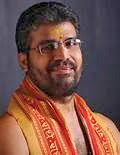The Process of Yoga : 2.8. - Swami Krishnananda.
========================================================================
=======================================================================
Friday, June 29, 2022. 06:00.
Chapter 2: The Structure of the Universe-8.
=======================================================================
Samsara, or the world of tension, has been created on account of the coming together of the two principles of consciousness and externality, purusha and prakriti. This tension of samsara cannot be remedied until we reach the point wherein they converge from where they emanated from the mahat-tattva as two
parallel lines of evolution. In the Kathonanishad there is a description of these two lines of evolution meeting at one point. Indriyebhyaḥ parā hy arthā, arthebhyaś ca param manaḥ, manasaś ca parā buddhir buddher ātmā mahān paraḥ (1.3.10). Mahataḥ param avyaktam, avyaktāt puruṣaḥ paraḥ, puruṣān na paraṁ kiñcit: sā kāṣṭhā, sā parā gatiḥ (1.3.11). Beyond the objects of perception there are the subtle essences called the tanmatras, the principles of objectivity, which are the causative factors of the five elements perceived by the organs of sense. Beyond the organs of sense are the objects, beyond the objects are their subtle essences, and beyond these essences is the mental principle which cognises these essences of objects. Beyond the principle of the mind there is the principle of understanding, or buddhi. The intellect is superior to the mind, the mind is superior to the senses, and the senses are superior to the objects.
Now, with the intellect we have exhausted all our faculties. Beyond the intellect we have nothing with us. We cannot know or see anything transcendent to the power of logical understanding, or buddhi. "But," says the Kathopanishad, "there is something beyond the buddhi – buddher ātmā mahān paraḥ. Mahan-atma is the mahat-tattva of the Samkhya, what is called Hiranyagarhha in the Vedanta, or Brahman in the Epics and the Puranas. It is also called the Creative Energy. That is the point where the subject on one side and the object on the other side meet or converge.
Mahataḥ param avyaktam. Beyond the mahat tattva is that peculiar Will to create, or the decision to manifest, emanating from an indeterminate principle to which I made reference as mentioned in the Nasadiya Sukta of the Rig Veda. Avyakta, unmanifest, is the principle of Ishvara or the Ishvaratattva, the principle of God, the Will to create, wherein is the explanation for all things. When we reach the seed of the tree, we have an explanation for all that we see as a manifested tree. When we reach this Supreme mahat-tattva and avyakta, which are the seed of this vast creation, we have a final answer to all our questions and a solution to all our problems.
But beyond still, beyond this causative principle of avyakta, is the Absolute. This is called the ultimate purusha or the Purushottama. It is called Purushottama because it is transcendent purusha and not merely the consciousness involved in creation. Dvād imau puruṣau loke kṣaraś cakṣara eva ca, kṣaraḥ sarvāṇi bhūtāni kūṭhastho'kṣara ucyate (Gita 15.16). Uttamaḥ puruṣas tva anyaḥ paramātmety udāhṛatḥ (Gita 15.17). This Paramatman, or the Purushottama, is beyond both prakriti and purusha. It is not the purusha involved in samsara, and it is also not the prakriti, the objective principle. It is the supreme regulative order of the universe wherein the constitution of all creation is laid down once and for all. It is difficult to name it, designate it; and until we reach that state, we are samsarins.
There is no use asking questions until we reach that state. No question can be answered until the original, fundamental law is studied – just as in law or legal practice we have one law regulating another law, one thing determining another principle. If a Patwari comes and asks for revenue, we can ask him, “Why do you ask revenue from me?” “It is the Sub-collector's order.” “But why did the Sub-collector order this?” “It is the District Collector's order.” “Why did he order this?” “It is the order of the Chief Secretary of the State Government.” “But why did he order this?” “It is according to the constitution of the State Government.” “But who made the State Government's constitution?” “It is in accordance with the constitution of the Central Government.” “Who made it, and why should it have been made in that way?” Then we go to the very principle of the enactment of law itself. Why should the law be enacted in that manner, or at all? This is the theory of law and the principle of law in jurisprudence. Likewise, in spiritual jurisprudence we have a tracing of the principle of law from the lower law to the higher law, and we cannot understand the action of a particular representative of the law or the constitution unless we study the whole constitution. The fundamental laws have to be studied first.
To be continued .....
========================================================================






Comments